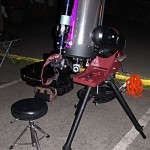A supernova, a comet, a new camera and a dark night.
I have had the Canon 60D for a while now. Since April in fact. It was my main carry camera in Alaska this summer. This was the camera used to produce the laser shots and videos that were published far and wide. But I have never used the camera on a telescope. A new Moon observing weekend is an opportunity to change that.

While my camera was busy shooting sequences, I wandered around and visited with the other folks enjoying the night. A few peeks through other scopes at favorite objects was about all the visual observing I did. There were a couple groups using cameras without telescopes to shoot stars capes under the dark sky. We traded hints as multiple cameras worked the night.
An orange glow in the clouds betrayed new lava flows on Kilauea. Even thirty miles away we could make out bits of a channelized a’a flow. The pair of binoculars I had brought became one of the most popular optical instruments around.
I was using the rig without any autoguiding, as a result guiding errors spoiled a number of exposures. I kept the exposures short, and shot bright objects. I have sequences to process of a lot of old favorites… M31, M42, a few open clusters like M11 and M38, the Pleiades and more. Just before dawn I even shot a sequence of the Tarantula Nebula skimming the slope of Mauna Loa. Two 8Gb SD cards filled and part of a third. I will be some time processing the many images taken through the night. There is even some video of Jupiter and Mars to process into high resolution planetary images.
There were three telescopes still operating when dawn appeared. Maureen, Cliff and myself watched as the sky grew bright and a thin crescent Moon rose above the slopes. Even then we spent a little time observing and photographing the Moon or Mars as the stars disappeared. We were still breaking down gear as sunlight swept the hillsides around us. Tired and yet elated we greeted the Sun.

